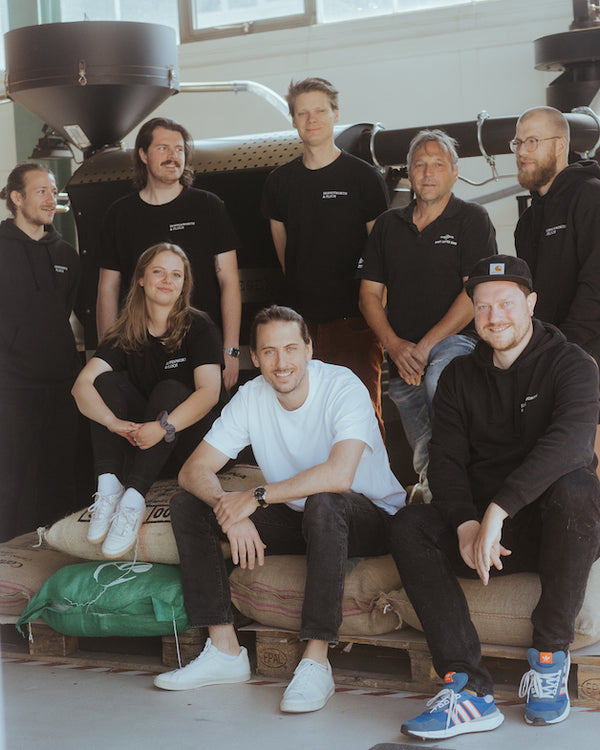Your Cart is Empty
Free international shipping available//New seminar dates every first friday of the month!
Free international shipping available//New seminar dates every first friday of the month!
Free international shipping available//New seminar dates every first friday of the month!
Free international shipping available//New seminar dates every first friday of the month!

June 02, 2023 3 min read
If you've ever been to our webshop, you've probably noticed that we re always communicating the "process" with our coffees. But maybe you have ever wondered what is actually meant by this? With this blog, we want to take a look at it!
What we call "process" in our communication is sometimes also called "preparation" or "processing" in English in the industry, and is an elementary step within the production chain of coffee that takes place directly after the harvest. To do this, you need to know that what we know as a "coffee bean" is nothing more than the kernel of a fruit commonly called a coffee cherry, which grows on coffee plants - similar to the kernel of a cherry, for example. Coffee farmers harvest those coffee cherries, and at that point things become clear: they are now, of course, faced with the question of how to get to the pit inside the cherry. Fortunately, there are many different techniques for doing this - the step is collectively known as "processing" (or just "preparation" or "processing").
So the goal of processing is always to end up with a fully exposed coffee bean. To achieve this, there are various procedures, which we will take a closer look at in a moment. First, some basic information: no matter which technique you look at - the starting point and the end point are nevertheless usually very similar. It always starts with a fruit and the end point is always a coffee bean dried to 10-12% moisture content.
The three most common processes (aka: preparation methods) are called washed, natural and honey processing. In the washed process (also: washed/wet processing), the coffee cherry is first de-pulped, i.e. freed from the pulp. Any remaining residues are then washed away under water - hence the name of this processing method. The now cleaned coffee beans are then dried in the sun for a few days, with constant turning, to a moisture content of approx. 10-12%. A washed preparation helps the coffee to very clean taste with clear acid structures.
The natural process (also: dry preparation or dry processing) works the other way around: first, the coffee cherries are completely dried whole and only then mechanically separated from the pulp. Here, too, the drying process takes place under the sun. In contrast to washed processing, the pulp of the coffee cherry has a much longer effect on the coffee bean, which usually results in significantly sweeter, fruitier coffees. However, naturals only exceptionally achieve the clear cleanliness of washed processed coffees in taste.
Somewhere in between is the so-called honey process (also: pulped natural or semi-washed). Here, a part (!) of the coffee cherry is first removed; how much can vary. Sometimes it is only the outer skin of the coffee cherry, sometimes almost everything except a small residue. The partially pulped coffee cherries are then dried, and the remaining pulp (the so-called mucilage) forms a sticky layer when exposed to sunlight - hence the name. Sensory honey processed coffees are not so directly to describe - there are, also due to different amounts of remaining pulp, partly significant differences.
Processing is not only the necessary condition to obtain coffee beans at all, it also has immense effects on the final taste of the coffee. First, every processing method involves some form of fermentation process that has flavor implications. Further, processing is a step in which an extremely large number of failure factors lie dormant: failure of fermentation, insufficient or uneven drying affect the coffee extremely negatively in terms of taste and can have dramatic economic consequences for farmers and producers.
It is therefore not surprising that processing has received increased attention in recent years - not only on the consuming side but also and especially among farmers and producers. The development is by no means surprising: while for coffee that is NOT rated as Specialty the pricing does not depend on sensory qualities, the opposite is the case for Specialty - all the more important is successful processing. Especially in Colombian coffee growing, we have been observing for several years that a young generation of ambitious coffee producers is experimenting intensively with new forms of processing. The results are sensory amazing and the achieved prices of these coffees give the addressed producers economically right.
10% discount on your first coffee order.And more: Sign up for our newsletter and never miss coffee releases, offers and background stories again.

Subscribe to our newsletter to receive coffee news, offers and background stories via email. Plus, you'll get 10% off your 1st coffee order.